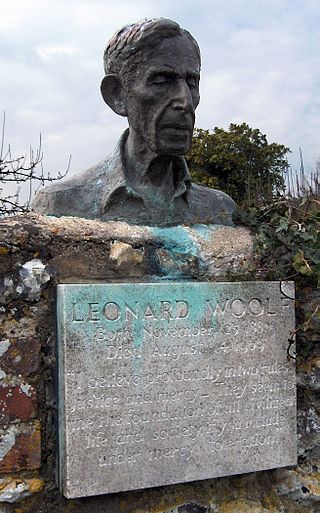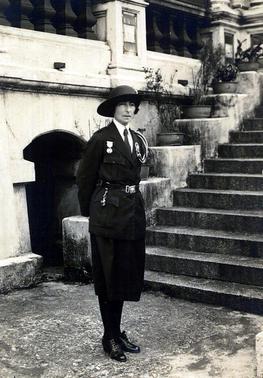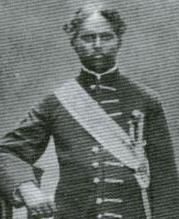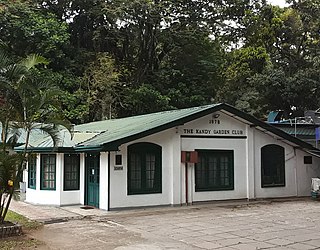Related Research Articles

The history of Sri Lanka is unique because its relevance and richness extend beyond the areas of South Asia, Southeast Asia and the Indian Ocean. The early human remains which were found on the island of Sri Lanka date back to about 38,000 years ago.

SephardicJews, also known as Sephardi Jews or Sephardim, and rarely as Iberian Peninsular Jews, are a Jewish diaspora population associated with the Iberian Peninsula. The term, which is derived from the Hebrew Sepharad, can also refer to the Jews of the Middle East and North Africa, who were also heavily influenced by Sephardic law and customs. Many Iberian Jewish exiled families also later sought refuge in those Jewish communities, resulting in ethnic and cultural integration with those communities over the span of many centuries. The majority of Sephardim live in Israel.

Leonard Sidney Woolf was a British political theorist, author, publisher, and civil servant. He was married to author Virginia Woolf. As a member of the Labour Party and the Fabian Society, Woolf was an avid publisher of his own work and his wife's novels. A writer himself, Woolf created nineteen individual works and wrote six autobiographies. Leonard and Virginia did not have any children.
Burgher people, also known simply as Burghers, are a small Eurasian ethnic group in Sri Lanka descended from Portuguese, Dutch, British and other Europeans who settled in Ceylon. The Portuguese and Dutch had held some of the maritime provinces of the island for centuries before the advent of the British Empire. Burgher people are often referred to as belonging to one of two sub-groups, either Dutch Burghers or Portuguese Burghers, though both are of mixed descent.

Sir Wilfrid Thomas Southorn, known as Tom, was a British colonial administrator, spending the large part of his career in Ceylon before serving as Colonial Secretary of Hong Kong, then Governor of The Gambia.

Pereira is a surname in the Portuguese and Galician languages, well known and quite common, mostly in Portugal, Galicia, Brazil, other regions of the former Portuguese Empire, among Galician descendants in Spanish-speaking Latin America. The adoption of this surname also became common among Sephardic Jews of Portuguese origin and was historically spread throughout the Sephardic Jewish diaspora. Origin: toponymic/natural world, from Latin pirum or pyrus. Currently, it is one of the most common surnames in South America and Europe. Started as a noble Christian toponym of the Middle Ages, taken from the feudal estate of Pereira, Portugal, which in Portuguese means 'pear tree'.

Henry de Worms, 1st Baron Pirbright PC, DL, JP, FRS, known before his elevation to the peerage in 1895 as Baron Henry de Worms, was a British Conservative politician.

British Ceylon, officially British Settlements and Territories in the Island of Ceylon with its Dependencies from 1802 to 1833, then the Island of Ceylon and its Territories and Dependencies from 1833 to 1931 and finally the Island of Ceylon and its Dependencies from 1931 to 1948, was the British Crown colony of present-day Sri Lanka between 1796 and 4 February 1948. Initially, the area it covered did not include the Kingdom of Kandy, which was a protectorate, but from 1817 to 1948 the British possessions included the whole island of Ceylon, now the nation of Sri Lanka.

Baron Charles George Maurice de Worms was an English chemist and lepidopterist.
Indians in Sri Lanka refer to Indians or people of Indian ancestry living in Sri Lanka, such as the Indian Tamils of Sri Lanka.

Bella Sidney Woolf OBE (1877–1960) was an English author, sister of author Leonard Woolf and first married to Robert Heath Lock, and in her second marriage to Hong Kong colonial secretary and colonial Ceylonese administrator Tom Southorn.

Gate Mudaliyar James Edward Corea was a Ceylonese colonial-era headman.

Tamil settlement of Sri Lanka refers to the settlement of Tamils, or other Dravidian peoples, from Southern India to Sri Lanka. Due to Sri Lanka's close proximity to Southern India, Dravidian influence on Sri Lanka has been very active since the early Iron Age or megalithic period.
George de Worms, 2nd Baron de Worms (1829–1912) was an Austrian aristocrat, and an English public official and banker.
Baron Anthony Denis Maurice George de Worms was an Austrian aristocrat and an English philatelist.
Baron Solomon Benedict de Worms was an Austrian aristocrat, plantation owner in Ceylon, and stockbroker in London.
Maurice Benedict de Worms (1805–1867) was an Austrian plantation owner in Ceylon.
Sephardic Bnei Anusim is a modern term which is used to define the contemporary Christian descendants of an estimated quarter of a million 15th-century Sephardic Jews who were coerced or forced to convert to Catholicism during the 14th and 15th centuries in Spain and Portugal. The vast majority of conversos remained in Spain and Portugal, and their descendants, who number in the millions, live in both of these countries. The small minority of conversos who emigrated normally chose to emigrate to destinations where Sephardic communities already existed, particularly to the Ottoman Empire and North Africa, but some of them emigrated to more tolerant cities in Europe, where many of them immediately reverted to Judaism. In theory, very few of them would have traveled to Latin America with colonial expeditions, because only those Spaniards who could certify that they had no recent Muslim or Jewish ancestry were supposed to be allowed to travel to the New World. Recent genetic studies suggest that the arrival of the Sephardic ancestors of Latin American populations coincided with the initial colonization of Latin America, which suggests that significant numbers of recent converts were able to travel to the new world and contribute to the gene pool of modern Latin American populations despite an official prohibition on them doing so. In addition, later arriving Spanish immigrants would have themselves contributed additional converso ancestry in some parts of Latin America.

The Village in the Jungle is a novel by Leonard Woolf, published in 1913, based on his experiences as a colonial civil servant in British-controlled Ceylon in the early years of the 20th century. Ground-breaking in Western fiction for being written from the native rather than the colonial point of view, it is also an influential work of Sri Lankan literature. It was republished by Eland in 2008.

The Kandy Garden Club is a social and sports club in Kandy, Sri Lanka, which was established in 1878 for the exclusive use by British coffee planters to play tennis. It is one of the oldest operating sports clubs in the country and the second oldest in Kandy.
References
- ↑ "Vol01chap04".
- ↑ "Jews of Sri Lanka: An Untold Story".
- ↑ "The Project Gutenberg eBook of the Itinerary of Benjamin of Tudela".
- ↑ Harris, Andrew (9 June 2011). "Secrets of Ceylon: What Happened to the Jews of Sri Lanka?". eJewish Philanthropy. Retrieved 22 March 2015.
- ↑ Wettimuny 2023, 7
- ↑ Wettimuny 2023, 8
- 1 2 3 William D. Rubinstein (ed.), The Palgrave Dictionary of Anglo-Jewish History, Palgrave Macmillan, 2011
- ↑ "Archived copy" (PDF). Archived from the original (PDF) on 2012-02-13. Retrieved 2016-07-19.
{{cite web}}: CS1 maint: archived copy as title (link)
Cited Works
- Wettimuny, Shamara. “‘The Jews of Ceylon’: Antisemitism, Prejudice, and the Moors of Ceylon.” Modern Asian Studies, 2023, 1–25. doi : 10.1017/S0026749X2300029X.